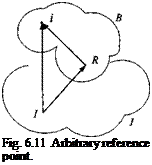Euler’s law according to Goldstein
The prevalent opinion of most books on classical mechanics or dynamics reflects the Newtonian viewpoint. I cite Goldstein2 only as an example. Actually, it was Daniel Bernoulli who issued the first account coinciding with Euler’s publication in 1744. Accordingly, the angular momentum equation can be derived from Newton’s linear momentum law.
Starting with Eq. (5.6), premultiply Newton’s law for a particle і by the skew – symmetric displacement vector S, y:
SuD1 (nijv’) = Suf,
If we can show that the left side equals that of Eq. (6.33), we have obtained Euler’s law. Apply the chain rule to the left side of Eq. (6.33):
D1 (miSuv’i) = niiD1 Snv I + SuD1 (m;v/)
= niiV’vl + S,/D'(ot, v,;) = SuD’ {m, v[)
Because the vector product of v with itself is zero, the equality is established. Therefore,
D1 {m і Suv[) = Sufi
and with the angular momentum already introduced l, = and moment
тц = Sufi we §et Euler’s law:
Df’j = ma
 |
Again we are faced with the choice of the inertial frame. The options we considered for Newton’s law are also pertinent here. Most often, for near-Earth simulations, we use the J2000 reference frame. If our vehicle is hugging the Earth, we can use the Earth itself.
I proceed now to derive two formulations that are most applicable to the modeling of aerospace vehicles. The first case represents Euler’s law of a rigid body referred to its mass center. This is the basis for the attitude equations of flight vehicles. The other formulation, useful for gyro dynamics, is Euler’s law of a rigid body referred to a point that is fixed both in the body and inertial frames and need not be the center of mass.











